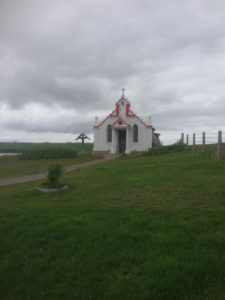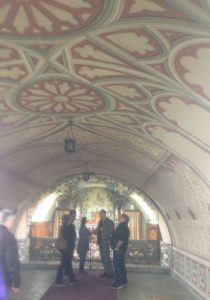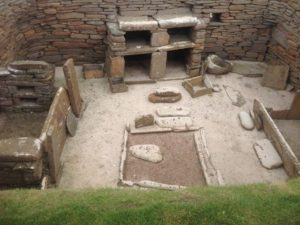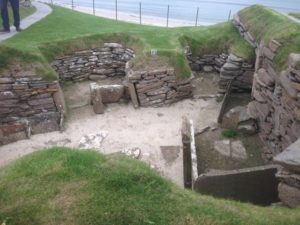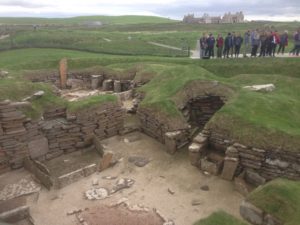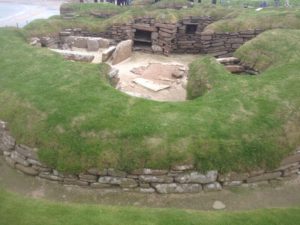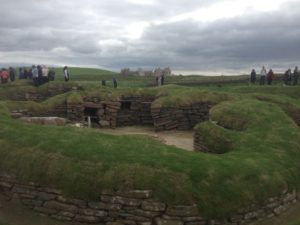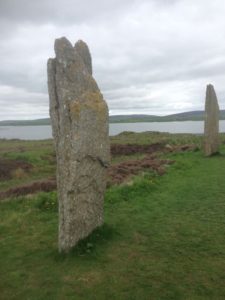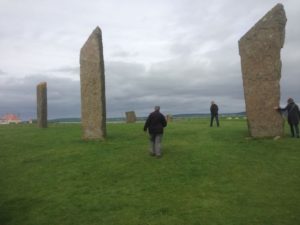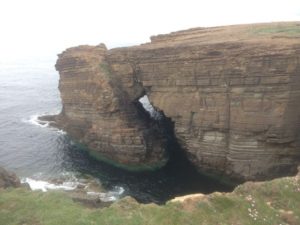In Kirkwall, Orkney Islands, we arrange for a small, six-person tour through Wildabout Orkney.
Rosemary met us at the port and whisked us away to the WWII Italian Chapel, built by Italian prisoners captured in North Africa, who had been brought to the island to help build the Churchill Barriers, cement block barriers to keep German subs from entering Scapa Flow, the deep-water harbor where the British fleet was gathered before the war. They had sunk old ships to block the channels but the tidal flow is so strong that one ship was dislodged and a German sub snuck in the harbor and in October 1939 sunk a training boat with 1200 men and boys (from 16-18), with the loss of 804 lives. The rest of the fleet had luckily gone out on maneuvers the night the sub snuck in.
To build the Churchill barriers, 1200 Italian prisoners were brought in and they requested permission to build a chapel in their spare time and out of two quonset huts and using only salvaged materials and cement, they built a beautiful chapel dedicated to peace. The interior is painted on plasterboard, the grill was made from scrap metal, the candlesticks from salvaged stair runner rods, the lanterns from beef tins. It is a moving testament to their faith and their artistry. The primary artist was Domenico Chioochetti and the grillwork was done by Giuseppe Palumbi.
When the barracks were being demolished, the chapel was saved only when the bulldozer operator refused to destroy it, and local residents got together and agreed to protect it.
We next headed for Skara Brae, a neolithic village occupied 5,000 years ago (3,000 BC, well before the pyramids).The settlement was discovered in 1850 when a storm blew away the sand to reveal the ruins of a neolithic stone village, with eight houses furnished with central firepit, stone beds and dressers and linked by covered passages.
The village had a sophisticated design, with indoor toilets connected by pipes that fed to the sea. Each house also had a clay lined pit that could have held sea water to keep the catch fresh until the next day. The underground passages that connected the houses are well suited to the area, which has strong winds. Each house could be shut off by a sliding stone door.
Next, we visited Skaill House, a manor house that dates to the 17th century and overlooks Skara Brae. The laird of the manor is the one who discovered Skara Brae after a storm.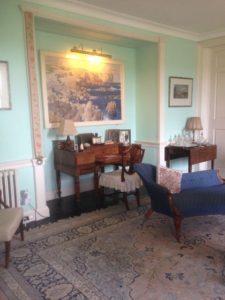
We didn’t get a chance to visit Maeshow (advance appointments are required), a burial mound built around 3500 BC. It was designed so that the light of the setting sun at the winter solstice focuses on the narrow passageway, illuminating the chamber inside.
The Ring of Brodgar is a circle 36 stones (originally 60) surrounded by a deep ditch. It is 130m across and it is set in a natural ring of lochs and hills. Clearly, the Neolithic people had a thing about circles.It is the third largest stone circle in the British Isles, larger and about 800 years older than Stonehenge.
An ambitious water drainage program is underway so part of the circle was closed off.
The Stones of Stenness, 1 mile away from Ring of Brodgar, has four giant stones that date back to 3100BC, making it one of the oldest stones circles in Britain. It is 1/3 the diameter of Brodgar but the stones are taller. It is believed to be a site for feasting before processions led along the bank of the lock up to the Ring of Brodgar. In 1814, there were 11 stones, but when Sir Walter Scott wrote a novel that popularized the site, tourists started visiting the site, to the annoyance of the tenant farmer, who decided to blow up the stones to rid himself of the tourists. In 1820, he drilled holes and inserted dynamite, succeeding in blowing up 7 of the stones as well as the Oden stone (that had a hole in the middle and was used in local weddings) before local residents realized what was happening and drove him off the island.
The Ness of Brodgar is a huge ceremonial site that dates back to 3100 BC. It was only recently discovered when a woman decided to put in a garden and discovered what were clearly archeological remains. It is just being excavated (fir 6 weeks in the summer).
Clearly, in this area, if you scratch the surface, you will find Neolithic remains.
Next, we visited the Yesnaby coast with spectacular rock formations.
While the others visited the distillery, we visited St. Magnus Cathedral, built between 1137 and 1200.




